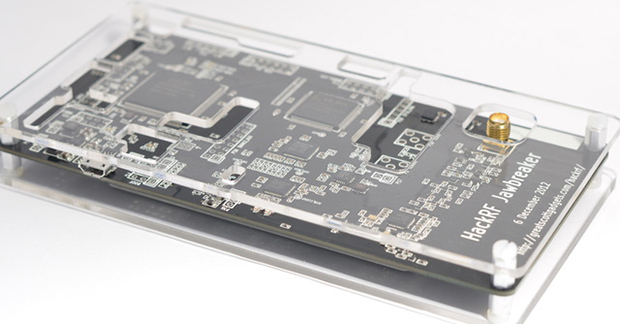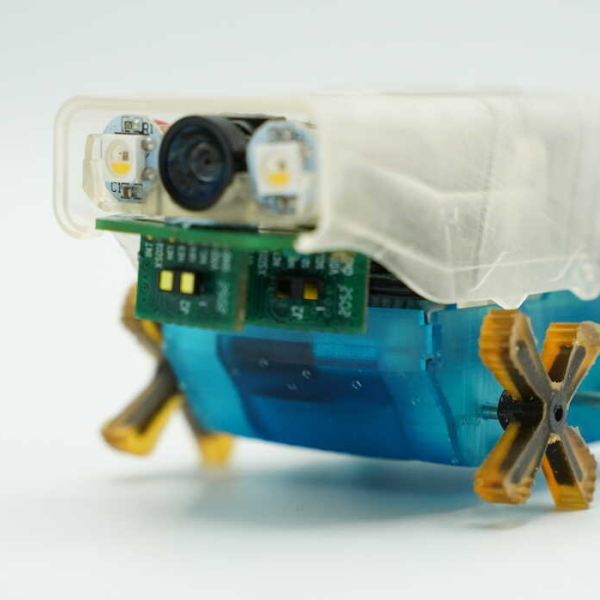Up on Kickstarter, [Michael Ossmann] is launching the HackRF, an inordinately cheap, exceedingly capable software defined radio tool that’s small enough to lose in your laptop bag.
The HackRF was the subject of a lot of interest last time it was on Hackaday – the ability to receive up to 6GHz allows the HackRF to do a lot of very interesting things, including listening in on Bluetooth, WiFi, and 4G networks. Also, the ability to transmit on these frequencies means a lot of very interesting, and quite possibly slightly evil applications are open to anyone with a HackRF. Like the RTL-SDR dongles, the HackRF works with GNU Radio out of the box, meaning all those cool SDR hacks we’ve seen so far will work with this new, more powerful board.
Compared to the USB TV tuner cards that were so popular a year ago, the HackRF has 10 times the bandwidth, is able to receive up to 6GHz, and is also able to transmit. It’s only half-duplex, so to receive and transmit simultaneously you’ll need two HackRFs, or maybe wait for a hardware revision that will hopefully come sooner rather than later.
Below you can check out [Michael]’s presentation at Toorcon where the HackRF was unleashed to the world.
[youtube=http://www.youtube.com/watch?v=g070WBv1ly0&w=580]

















Interesting…. Anyone know an estimate for BOM cost for the PCB only option?
Here is the BOM https://github.com/mossmann/hackrf/blob/master/doc/hardware/jawbreaker-bom.csv but I have not looked up the prices
Looking at Mouser and DigiKey (preferring Mouser, but not all parts are available at Mouser), it looks like about $95, plus shipping. It comes to about $78 in IC’s, and $17 of passive components.
Has anyone created a Mouser BOM?
What I want to know is, can you, while sacrificing some bandwidth, setup a frequency division multiplexing so you can implement a full-duplex scheme?
I asked Dan about those un-populated spots on the chip that look like they are for more antenna mountings. Turns out they are for syncing up 2 hackrfs… this was his reply.
“Those are for clock input and output. The idea is that you can use an
SMA cable to connect one Jawbreaker’s clock output to another’s input
and operate them synchronously. This would be useful for things like
multi-antenna techniques. Alternatively you could drive several
Jawbreakers from a single external clock source. This stuff is entirely
untested.”
I assume this could also be used to help make two hackrfs completely full duplex independent of software.
The impression I get is that being half duplex is more a hardware limitation than a software one. But I am shooting in the wind with that statement, some one will probably come up with a ingenious hardware mod after painstakingly dissecting the files on github.
Sorry if I did not answer the question just thought I would throw more info at it and someone smarter than myself can have more tools to give you an answer.
Wook.
Dan = Michael
It is very late and my brain is on the fritz… no idea who I was thinking of.
Oh of course Dan Osman the rock climber R.I.P.
Bed.
To do full-duplex, just buy 2. You wouldn’t need to synch their clocks or anything.
Actually, I wonder how much hardware the receive / transmit parts have in common? The onboard MCU does the hard work right?
If the rx / tx circuits are separate, it could be just a matter of programming and CPU power to do full-duplex. At the very least I suppose you could make 2 units yourself, and leave the rx components off one, and the tx off the other, just to save money.
Synchronizing the clocks provide other benefits and is common in RF gear. For example if you have a very accurate clock source then when you tune to 431.000 MHz that’s what you get instead of 430.992 MHz.
Full duplex is difficult on one board because the transmitter can leak back into the receiver. Think of listening to a faint whisper while someone is shouting in your other ear. The easiest way to avoid this is to have the transmitter and receiver physically separated each with their own antenna.
Steve
Ah, well that makes sense! Never thought of that. Still you could do Ethernet over half-duplex, just switching sides fast enough. So still lots you could do with just one.
I thinking that if you have a single antenna and two tuners (with enough bandwidth between two frequencies) that you can set up a full-duplex with FDM. Of course, total bandwidth would be reduced, but that would be acceptable. As for the leaks, if they are in anyway shape or form periodic, a band-pass filter (or some FFT filter setup in code) should clear that up. Then again, I’m just throwing the idea out there to see if it’s possible.
From what I understand with these guys no. They can only send or receive and not do both at the same time. They’re inherently half-duplex. So you’d need two of them to do any FDM or anything like that. That being said, they still look far cheaper than other solutions for doing that. What I haven’t found is what the total bandwidth of these guys is yet.
USB 2.0 is 480 Mbit/s (effective throughput up to 35 MB/s or 280 Mbit/s)
I and Q are 8 bit, so I would guess that their maximum bandwidth would be about 10MHz
And suddenly Espionage is no longer just a game for 4 players…
On the upside, more power to the people! ¡Viva la Pueblo!
Long live the village!?!
Also refers to the people :P
Viva el Pueblo!
(grammar nazi in Spanish :P)
TYPO 6MHZ should Be 6GHZ
Typo 6MHZ should be 6GHZ. Awesome device cant wait till its available.
My question is which is the better buy, hackrf or bladerf?
Neet device! Seems a shame though there’s only a small CPLD. Big SDR could really benefit from an FPGA and such.
Anybody know its frequency accuracy?
FCC might not be happy with this
obviously, you shouldn’t use this to transmit if you aren’t licensed to do so.
lol how naive..
someone’s never bought “Tobacco” pipes from a headshop.
In some countries you can’t even own an uncertified transmitter if you don’t have an ham license.
It’s test equipment, not a transmitter.
I didn’t know Jon Lajoie was this smart …
I thought I was high as fuck for a second there….
Far out, I hope the open source project results in affordable units assembled off the shelf availability. I happy to see that is a transceiver, a that would be my first use interest, and two transceivers can be used to build a full duplex station. Will be interesting to see what analog component will be developed to work with this. No doubt for some applications hardware band pass filters will be desirable, receive preamps, practical transmit power amplifiers in the amateur radio bands where they would be permitted to be used by licensed stations. I suspect down converters are used for MF HF.
Why wouldn’t you include all the way down to kHz?
if meant primarily meant for US and UK amatuer radio, most licenses are for above 30mHz. some special licenses go down further, but in regards to kHz ranges, there really isnt anything allowed below the 160 meter band.
Yeah but maybe I want to experiment with lower frequency things like RFID. There are still many interesting things happening below 30MHz.
This is usually how it is with bus and RF tools. Low bandwidth bus analyzers, and RF tools that are likely not to be used by license holders, designed by someone without the licenses who has at least tested it, all restricted designs..
I’m sure the 16 year old kids in suburbia USA who are mostly going to be buying this are all into HAM and FCC laws.. As I said in a higher comment: how naive
Finally I gonna have my first spectrum analyser, actualy much better than it.
man this would be great for spread spectrum, wonder how fast it can hop
Every time I see spread spectrum, I always think of Hedy Lamarr.
http://en.wikipedia.org/wiki/Hedy_Lamarr#Frequency-hopping_spread-spectrum_invention
Great project , but I’ll stick with my USRP for the mean time.
Be nice if they expanded and made an ExtIOxxx.dll for something like HDSDR… or even HRD.
I personally predict this will be a good buy for those of us into satellite stuff, since most of the L-band and up have higher bandwidth than are available with the RTL-based SDR’s… for instance, HRPT/HRIT is 3Mhz,..
I was able to snag a beta invite last fall and received my board in June. It’s a pretty slick, with a handful of git repositories and some cmake know how, it integrates with GNU Radio nicely. So far I’ve received FM radio stations and a 2m ham repeater, pretty basic stuff, but interesting none the less. Mike Ossman has done a great job with these boards!
I realize most people think ham radio is “old”, but really there’s a lot going on there that is quite modern. I just recently got my license, because why not, and I find it to be quite interesting and fun. It also inspired me to start tinkering with electronics, such as Arduino. I’m loving it, and SDR has a lot of promise here.
Modern uses include digital modes, cube sats (telemetry / telecommand), high altitude balloons, etc. I’ve had fun looking into APRS, field operations with low power (QRP), etc. I don’t care what anyone says. CW (code) may be old today, but it’s amazing how far you can reach with 1 -5 watts (or less), and a wire antenna thrown up a tree!
This is in addition to learning about the electronics / RF aspects, talking to people all over the world, learning about propagation, antenna experiments, etc. People have this image of their grandpa sitting in the basement with an old tube-based boat anchor transceiver, and that’s still around, but it’s much more than that. I’d like to see younger people get into it again. I love the internet as much as anyone, but RF is just awesome, and fundamental.
Getting into the HF bands can be a very expensive though. Entry level mobile / base stations such as the Yaesu FT-897d, Icom IC-7000, or Kenwood TS-480SAT will set you back around $900-1200 easy, just for the radio. The SDR’s available are also extremely expensive, because even among hams, they are still a niche market. The oldschool guys don’t want to give up their huge radios with buttons and knobs (and some of that is with fair reason ~ software menus on a small device can be cumbersome).
I’m getting ready to buy my first HF radio, I’ve been looking around for SDR’s that cost around the $500 price point, and there’s virtually nothing of high quality that I would replace one of the radios above with. In theory, SDR, interfaced with a computer, should be much less expensive to manufacture, but those savings are no where to be found except with a few kits out there.
make one that has a bottom freq. of 26 mhz and ill be sold
FYI, have recently tried the HackRF One on the AM broadcast band (530 – 1710 KHz) using a 43 foot vertical antenna and am very pleased with the reception. Have not ventured below that, such as 285 – 325 KHz where DGPS beacons are. A good antenna is the key to good reception.
FYI, have recently tried the HackRF One on the AM broadcast band (530 – 1710 KHz) using a 43 foot vertical antenna and am very pleased with the reception. Have not ventured below that, such as 285 – 325 KHz where DGPS beacons are. A good antenna is the key to good reception.
Sorry, too much coffee made me click twice! :)
$300 ? no thanks. Not for a $99 board.